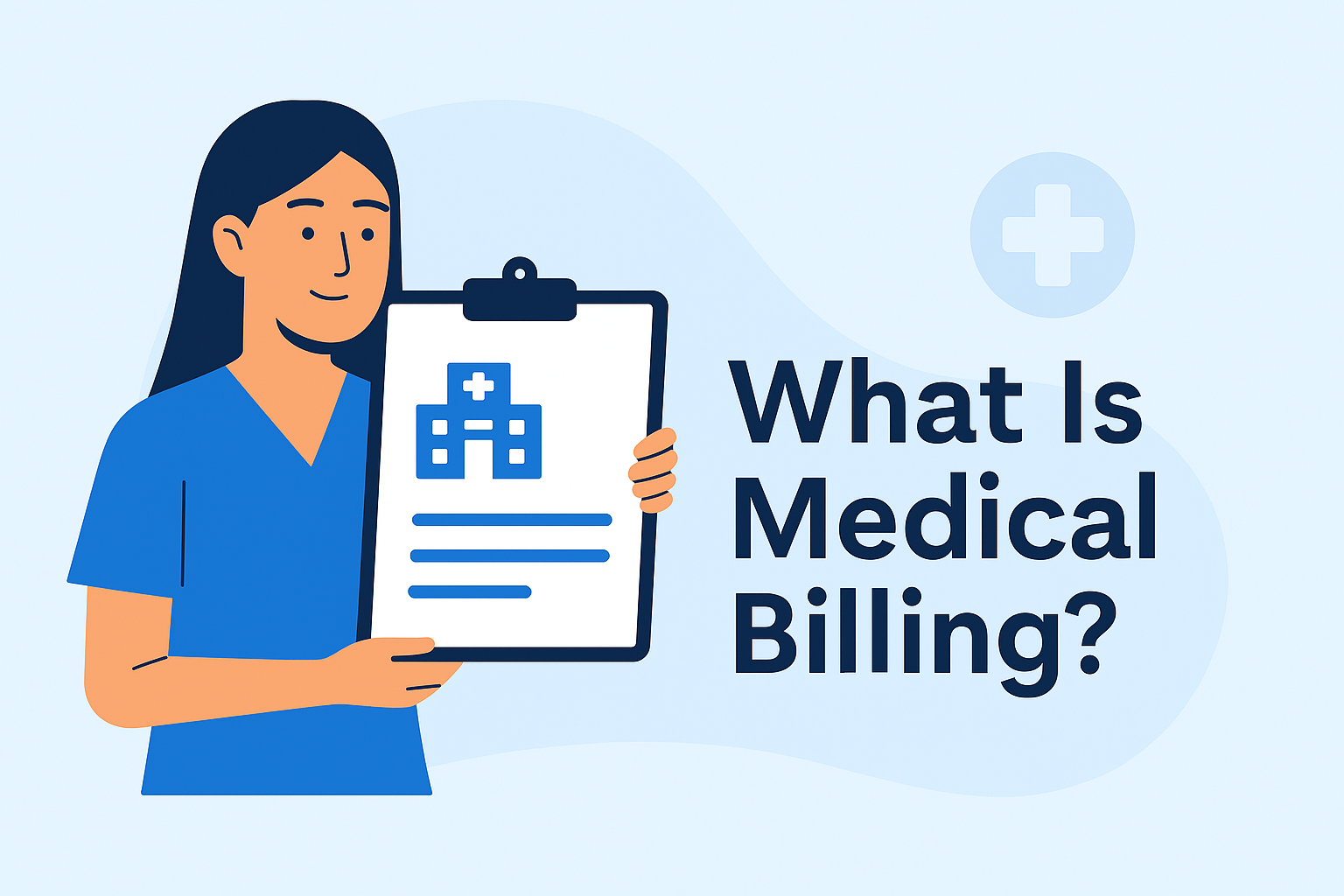What is medical billing? It’s the process of generating and submitting healthcare claims to insurance companies in order to receive payment for services rendered by healthcare providers. It’s a critical component of the healthcare revenue cycle, ensuring that providers are reimbursed for patient care. A knowledgeable medical biller plays a key role in maximizing revenue and minimizing delays or denials.
What Is Medical Billing and How Does It Work?
The medical billing process starts before a patient ever sees a provider. It continues through treatment, claim submission, reimbursement, and patient billing. The process includes collecting patient information, verifying insurance coverage, preparing claims, following up on payments, and managing denials or appeals.
An efficient billing process ensures faster payments, reduces errors, and improves the overall financial health of a medical practice or facility. Understanding what is medical billing can help patients avoid claim denials and protect their financial health.
If you’ve ever asked yourself “what is medical billing,” you’re not alone. Many patients don’t realize how much happens behind the scenes to ensure a doctor’s visit gets covered by insurance.
Medical Billing vs Medical Coding
While medical billing and coding are closely related, they serve distinct functions. Coders translate clinical notes and treatment details into standardized codes using CPT, ICD-10, and HCPCS systems. Billers use those codes to create and submit insurance claims. In smaller practices, one person may handle both roles, but in larger organizations, these are often separate specialties.
Both require knowledge of medical terminology, anatomy, and payer requirements. Coders ensure accuracy in clinical documentation, while billers focus on financial processing, claim submission, and payment tracking.
Front-End vs Back-End Medical Billing
Front-end billing happens before and during the patient visit:
Insurance verification
Preauthorization
Patient registration
Collecting copays
Generating encounter forms
Back-end billing occurs after the visit:
Charge entry
Claim generation and scrubbing
Claim submission
Payment posting
Denial management
Patient invoicing and collections
Both ends are crucial. Mistakes in front-end billing can lead to denied claims, while back-end inefficiencies delay reimbursement.
The Medical Billing Cycle: Step-by-Step
1. Pre-registration & Registration
Collect patient demographics and insurance information to verify eligibility and obtain preauthorization.
2. Insurance Eligibility Verification
Confirm plan details, coverage limits, and co-payment responsibilities.
3. Point of Service Collections
Collect copays, deductibles, and any outstanding balances at check-in or check-out.
4. Encounter Form Generation
Document the services performed during the patient visit using a superbill.
5. Charge Entry
Input codes and charges into the practice management system.
6. Claim Generation
Compile patient, provider, and service info into a formal insurance claim.
7. Claim Scrubbing
Use software to review claims for errors before submission.
8. Claim Submission
Send claims electronically to payers or via clearinghouses.
9. Claim Tracking
Monitor claim status, correct rejections, and follow up as needed.
10. Payment Posting
Record payments from insurers and patients into the billing system.
11. Patient Invoicing
Send statements for remaining balances, with clear breakdowns.
12. Denial Management
Identify, correct, and appeal denied claims to maximize reimbursement.
13. A/R Collections
Follow up with patients on unpaid balances, offer payment plans, and ensure collection.
14. Credit Balances
Identify and refund overpayments to stay compliant and avoid legal risk.
Who Needs to Understand Medical Billing?
Medical billing isn’t just for billers and coders. Patients who understand the billing process are less likely to get caught off guard by unexpected bills. Healthcare providers and office managers also need to know what is medical billing to run efficient practices. Even legal and insurance professionals benefit from this knowledge when resolving claim disputes or appeals.
Tools and Software Used in Medical Billing
Today’s medical billing professionals rely heavily on technology. Practice management systems (PMS), electronic health records (EHR), and billing clearinghouses are just a few of the tools used. Claim scrubbing software helps detect errors before submission. Many platforms integrate with scheduling, charting, and payment tools to streamline the entire billing cycle. Understanding what is medical billing also means understanding how these tools support accuracy and efficiency.
Common Challenges in Medical Billing
Even with the best systems in place, medical billing is never completely error-proof. Common issues include:
Missing or incorrect patient data
Coding inaccuracies
Missed claim filing deadlines
Lack of preauthorization
High denial rates from insurers
Each of these challenges can delay payments, increase administrative workload, and harm patient satisfaction. That’s why having skilled billing professionals is essential.
How to Get Help With Medical Billing Issues
If you’re struggling to understand a bill, appeal a denial, or fix an error, don’t hesitate to reach out to your provider’s billing department. Many healthcare offices have staff trained to explain charges and help you navigate your insurance plan. You can also work with a medical billing advocate or explore third-party services that specialize in denied claims and patient advocacy.
According to CMS.gov, accurate billing and coding are essential to prevent fraud and ensure proper reimbursement.
Why Accurate Medical Billing Matters
Proper medical billing ensures providers are paid for their services, keeps operations running smoothly, and minimizes patient frustration. Denied or delayed claims affect the bottom line and can snowball into compliance and legal issues.
Certified and well-trained medical billers are the backbone of a financially stable healthcare organization. If you’ve ever wondered what is medical billing and why it’s important, this guide breaks it down.
Final Thoughts: Building a Stronger Medical Billing Process
Now that you know what is medical billing, you’re better equipped to spot issues and avoid claim denials. Understanding and optimizing the medical billing process helps prevent errors, speeds up reimbursement, and improves patient experience. Whether you’re a provider, administrator, or patient navigating denied medical claims, knowing how billing works is essential.
Stay tuned to DeniedMedicalClaims.com for more guides on appeals, common billing issues, and ways to protect your healthcare rights.
Curious about the next step? Learn how to appeal a denied medical claim in our detailed guide.







